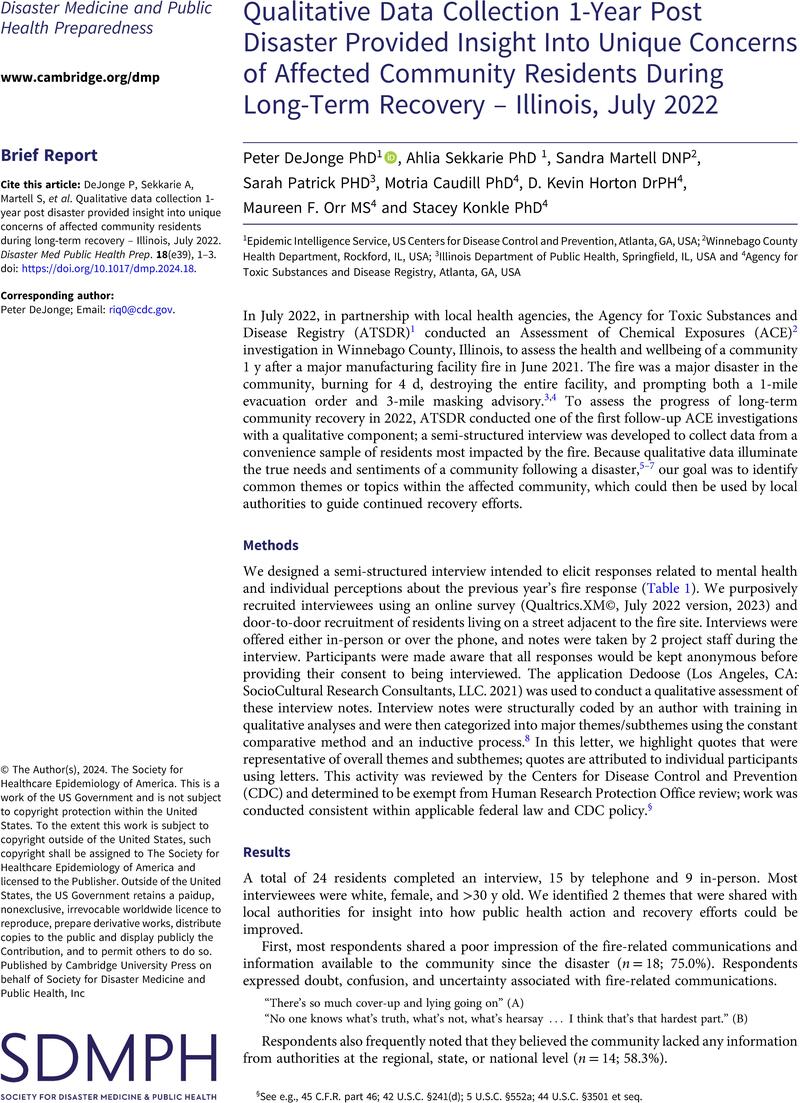No CrossRef data available.
Article contents
Qualitative Data Collection 1-Year Post Disaster Provided Insight Into Unique Concerns of Affected Community Residents During Long-Term Recovery – Illinois, July 2022
Published online by Cambridge University Press: 28 February 2024
Abstract
An abstract is not available for this content so a preview has been provided. Please use the Get access link above for information on how to access this content.

- Type
- Brief Report
- Information
- Creative Commons
- This is a work of the US Government and is not subject to copyright protection within the United States. To the extent this work is subject to copyright outside of the United States, such copyright shall be assigned to The Society for Healthcare Epidemiology of America and licensed to the Publisher. Outside of the United States, the US Government retains a paidup, nonexclusive, irrevocable worldwide licence to reproduce, prepare derivative works, distribute copies to the public and display publicly the Contribution, and to permit others to do so. Published by Cambridge University Press on behalf of Society for Disaster Medicine and Public Health, Inc
- Copyright
- © The Author(s), 2024. The Society for Healthcare Epidemiology of America
References
Sudweeks, S, Elgethun, K, Abadin, H, et al. Applied toxicology at the Agency for Toxic Substances and Disease Registry (ATSDR). In: Encyclopedia of Toxicology. Elsevier; 2024:761-767. doi: 10.1016/B978-0-12-824315-2.00555-8
CrossRefGoogle Scholar
Konkle, S, Horton, DK, Orr, M. Assessment of Chemical Exposures (ACE) Program: toolkit advances and recent investigations. J Environ Health. 2023;86(4):36-39, 44.Google Scholar
Nakayama, JY, Surasi, K, Owen, LR, et al. Assessment of chemical exposures investigation after fire at an industrial chemical facility in Winnebago County, Illinois. J Environ Health. 2023;85(7):8-15.Google ScholarPubMed
Surasi, K, Nakayama, JY, Johnson, M, et al. Notes from the field: deployment of an electronic self-administered survey to assess human health effects of an industrial chemical facility fire — Winnebago County, Illinois, June–July 2021. MMWR Morb Mortal Wkly Rep. 2021;70(49):1715-1716. doi: 10.15585/mmwr.mm7049a4
Google Scholar
Tanaka, E, Tennichi, H, Kameoka, S, et al. Long-term psychological recovery process and its associated factors among survivors of the Great Hanshin-Awaji Earthquake in Japan: a qualitative study. BMJ Open. 2019;9(8):e030250. doi: 10.1136/bmjopen-2019-030250
CrossRefGoogle ScholarPubMed
van Kessel, G, Gibbs, L, MacDougall, C. Strategies to enhance resilience post-natural disaster: a qualitative study of experiences with Australian floods and fires. J Public Health (Oxf). 2015;37(2):328-336. doi: 10.1093/pubmed/fdu051
Google Scholar
Fillmore, EP, Ramirez, M, Roth, L, et al. After the waters receded: a qualitative study of University Official’s Disaster Experiences during the Great Iowa Flood of 2008. J Community Health. 2011;36(2):307-315. doi: 10.1007/s10900-010-9312-z
CrossRefGoogle ScholarPubMed
Glaser, BG. The constant comparative method of qualitative analysis. Soc Probl. 1965;12(4):436-445. doi: 10.2307/798843
Google Scholar
Kobayashi, T, Takebayashi, Y, Goto, A, et al. May risk communication with non-experts contribute to post-disaster restoration of normalcy? A survey on the disaster-struck prefectures after the Great East Japan Earthquake. Int J Disaster Risk Reduct. 2021;65:102564. doi: 10.1016/j.ijdrr.2021.102564
CrossRefGoogle Scholar
Savoia, E, Lin, L, Viswanath, K. Communications in public health emergency preparedness: a systematic review of the literature. Biosecur Bioterror. 2013;11(3):170-184. doi: 10.1089/bsp.2013.0038
Google Scholar
Houston, JB. Public disaster mental/behavioral health communication: Intervention across disaster phases. J Emerg Manag. 2012;10(4):283-292. doi: 10.5055/jem.2012.0106
Google Scholar
CDC. CDC clear communication index. Published online August 2019. Accessed February 4, 2024. https://www.cdc.gov/ccindex/pdf/clear-communication-user-guide.pdf
Google Scholar
CDC. NCEH/ATSDR Clear Writing Hub. Environmental health social media toolkit for partners. Accessed February 4, 2024. https://www.cdc.gov/nceh/clearwriting/social_media_toolkit.html
Google Scholar




